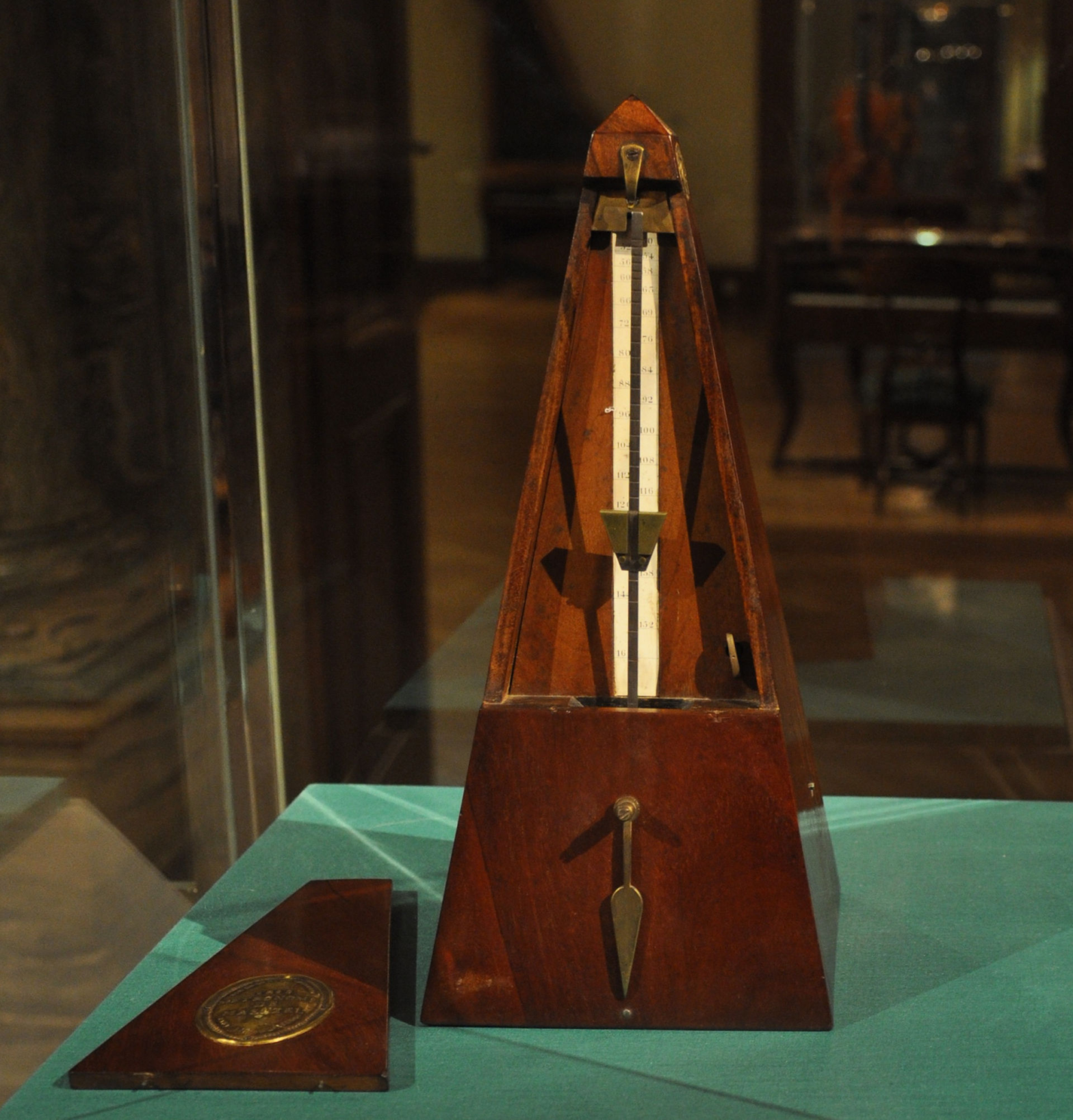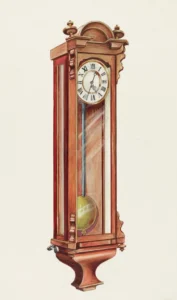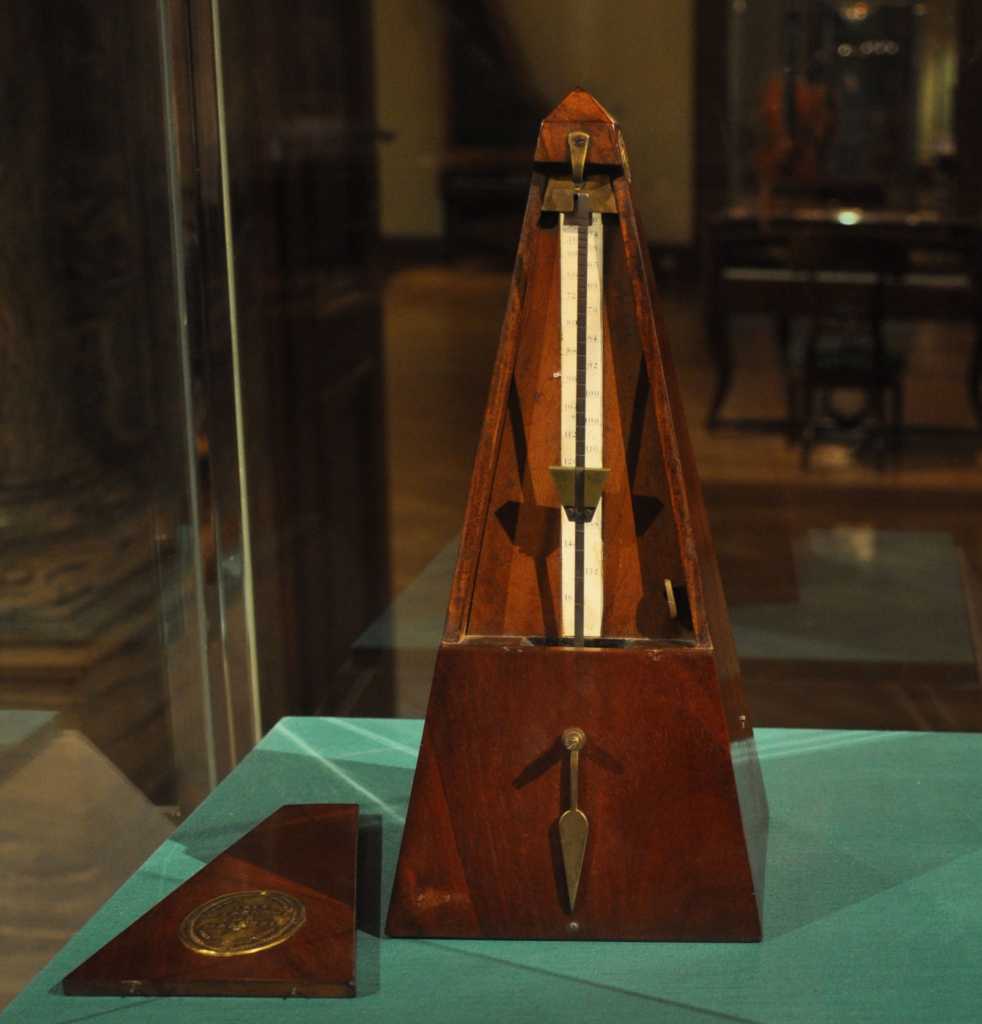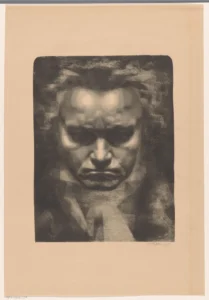Your cart is currently empty!
The Marvellous Mr Maelzel

The Metronome Revolution
In any musical culture there is an exciting turning point that occurs when music as a professional industry starts to emerge. Musicians start to play other musicians’ music, rather than just their own: composers are writing music down for people in the future (or in other countries) to play, multiple performances of major new works are being produced and interesting cultural exchanges occur. This can lead to fundamental shifts in the standardisation of instrument technologies and of music notation to enable disparate musicians to collaborate and understand each other.
When this emerged in Europe it would have been a heady and exciting time, but as you move away from the composer-performer and into the writer-composer a simple but important problem arises: Tempo. If I write a work and share it with you you (via horse and carriage, or perhaps printed and in a foreign bookshop, or jotted down in a notebook to share with a friend) how fast do you play it? How long is the piece? What’s the energy of it?
As composers move away from being the performers, conductors and distributors of their own works (as Vivaldi, Bach or Mozart did), this becomes more of a problem. It becomes a problem for the Churches as liturgical music moved around Europe, it would have been a problem for secular concerts as audience demanded international ‘hits’. And if you can’t ask the composer directly, you ask him to write something in the score. So in those early scores they mostly used simple descriptive language to denote speed and feel, such as fast, sad, majestically, Allegro, Andante, Schnell.
This was a basic feature of some of the earliest written music, but this style of doing things can cause new and different problems. Every student composer has had to deal with the problem of shared language. You can indicate that a particular piece is ‘fast’, or another one is a ‘slow walking pace’, but my walking pace might be faster than yours, or perhaps your idea of ‘sad’ is a fast and flowing sadness, or my ‘majestic’ is a really slow majestic whereas yours is energetic .
Listen to the range of tempos conductors will pick for a common orchestral work and you can see the issue: these speeds will differ by 10s of beats-per-minute from their colleagues, and they may also be going faster and slower at different points in the work.
As works start to travel internationally there is also a big translational problem: these are often words in other languages. The musician reading an unfamiliar score has to work out the difference between Maestoso and Eroico, or how fast Allegro Appasionata is compared to a Andante Esspressivo. Setting aside poetic or emotional similes, often the first task is a simple practical one: what speed do we play this piece? How many bars are there in a minute or how many seconds does a note last for?
The solution for these problems would be a device eventually called the metronome. Until it’s standardisation musicians tried all sorts of gizmos: pendulums, clockwork, heartbeats, steps. But these were rough and ready guesses. They were useful for someone playing to their own pulse, but there was no translatability between one person’s device and someone else’s.

One musician might just have a weight on a string that went back and forward. Or another’s clocks might have the luxury of a second hand if you could afford one, but that would only give you one speed (approximately 1Hz/60BPM) meaning you had to do complicated maths. Or you might have a pendulum similar to the one hanging from a long-case clock that you could make swing faster and slower by adjusting the weight up and down. But how do you know what speed it is swinging at, and how is your grandfather clock different to my grandfather clock? Accuracy at this point is impossible and so the devices were useless for the working musician.

So we introduce the hero of this story, Viennese entrepreneur, entertainer and inventor Johann Nepomuk Maelzel. After early success as an inventor of musical and technical curiosities he bought and sold many of Europe’s famous automata, including the Mechanical Turk chess-playing machine. Later in life he set up travelling exhibition of automata that moved and played music, before dying of alcohol poisoning on a boat full of machines off the coast of Argentina.
The beginning of the 19th century was the peak of the early development of creative robotics and the public craze for orchestrions and mechanical instruments, which were huge tourism attractions and spectacles. Common machines at the time included automatic instruments such as player pianos and organs, adding violins, trumpets and drums, and the early ancestors to the steam-driven fairground organs which today haunt our nightmares. This was also the only way to listen to music at the time without playing it yourself or paying a musician, and so these were enormously popular as curiosities and as entertainments.
Maelzel invented a few of these mechanical self-playing instruments, and had early financial and reputational success with an orchestrion. Through this he made friends with the musical circles of Vienna, becoming particularly close with Beethoven and collaborating with him to write a piece for his new tourable Panharmonicon, a collection of military instruments building on the popularity of the Napoleonic wars.
The overture Beethoven wrote still exists, albeit in a longer form and orchestrated for real musicians. For a short while Maelzel and Beethoven were in a business partnership, before inevitably falling out and taking each other to court: both of them were famously difficult personalities who fell out with many of their collaborators. Later in life they reconciled, and Maelzel invented an improved ear trumpet for Beethoven, and helped him with his deafness in other mechanical ways.
Beethoven was one of the first composers that was writing music that he wouldn’t hear – a) because he was deaf, but also b) he’d be sending stuff off to a different city because they bought a piece from him. He wouldn’t necessarily perform or attend these performances, as he didn’t have a performing profile later in his career. Because of that he had a real need for a musical chronometer.

Maelzel, almost as an afternoon side hobby, invented a simple clockwork metronome with an inverted adjustable pendulum. Other inventors had made similar things before, but his huge innovation was putting a little paper strip of numbers down the middle of it, behind the pendulum, that said the beats per minute.
That piece of paper was the amazing innovation that meant that if you had a metronome and I had a metronome, and you wrote on your piece “this is 110” I could set mine to 110 and they’d both click at exactly the same speed. And for Maelzel this was also great as to make this trick work you’d be able to sell two of them.
Beethoven absolutely loved this. He was the first high profile customer, his scores of this period are littered with handwritten markings like “MM = 92”. The MM stands for ‘Maelzel’s metronome’, rather than ‘Metronome Marking’ as people often think, but Beethoven thought in German, so it didn’t.
Beethoven started putting metronome markings on all of his works after that point and even went back and added markings to some of his older pieces. Lots of these markings are still in the published scores that are used today. However, many of his metronome markings are ridiculously fast and unplayable for modern performers and there’s long been a theory that his metronome didn’t work. Research was done a few years ago that explored a number of possible theories as to why so many of his markings are inconsistent with how the pieces are performed. His physical metronome is in a museum and still functional so they were able to run it and check it, and we officially know now that it worked as expected.

The current best theory is that Beethoven didn’t know how to read his metronome. On most clockwork metronomes you have the little wedge-shaped weight that adjusts up and down the pendulum spine, and the flat top of the wedge corresponds to the mark on the piece of paper for that temp. Scholars now think he may have been reading off the bottom of the wedge rather than the top, which means that every tempo is somewhere between eight and 16 beats per minute too fast.
For a while it was thought that Beethoven wanted everything to be really, really fast and energetic. And some performances really try their best to execute the original Beethoven tempos, with spectacular and impressive results, but many of the tempos are virtually unplayable, despite being written in the score by the composer himself, and aren’t part of common performance practice.
Time ticks on…
So what’s happened since the 1820s and this fruitful collaboration between inventor and composer? Beethoven we know about: in 1827 he stopped composing and started decomposing. Maelzel embarked on a tour of America with a boatload of European automata, before dying of alcohol poisoning off the coast of Argentina in 1838.
And the metronome itself?
Maelzel’s design became the standard form for a mechanical metronome, pretty much identical to the ones you can buy today from a range of companies. There are now miniaturised ones, and ones with extra features, but the basic elongated pyramid design has stayed the same as the one Beethoven had sitting on his fortepiano.
The metronome is still a vital tool for musicians – every student or working musician has some form of metronome, and the technology has kept getting upgraded.
Early improvements meant the metronome could emphasise (often with a little bell) the first beat of a bar in multiple common time signatures, and also the strong and weak beats, all done with clockwork, cams, and springs.
Electromechanical metronomes, using switches and magnets, were introduced in the 20th century, quickly followed by fully electronic ones, with new ‘silent’ capabilities to flash a little bulb instead of the audible click.
Now, an online musician is targeted with ads for metronome apps for your phone, watch or tablet, websites which do the job for you, smart Bluetooth-enabled hardware that connect to your phone or control software. Smart-watches that you wear and vibrate to use while playing, or embedded metronomes in tuning devices or music-reading applications.
The digital metronome has meant that you can infinitely customise the beat pattern used, from complex compound time-signatures to alternating between time signatures or even automating tempo changes. Many of them include algorithms to detect the tempo and beat of an audio source. A world of possibility has opened up for the .
And yet, you can still use an original mechanical one for a lot of what you need, which is just a regular pulse to practice to or to work out how fast something is. Every conductor, every performer, every composer has a simple metronome somewhere that they can quickly set to the right tempo.
From tick to click
Parallel to these technical developments of the 20th century, the click track starts to be developed for movie production. At its most primitive level a click track is just a live feed or audio recording of a metronome, played into the musicians headphones while they’re recording so that everyone has the same pulse but that isn’t heard on the final soundtrack.
Early films recorded their soundtracks by having the musicians watch the screen and matching their performance to the action on-screen in real time, but as soon as there is ambition in the level of musical complexity or synchronisation this needs to be planned out in advance.
As ever, animation was the pioneer of the click track: Disney director Wilfred Jackson, who worked on the music for Steamboat Willie in 1928, simply used a metronome to set the precise speed of the music for individual scenes, which were then edited together into the full soundtrack.
What I worked out, was a bar sheet (or dope sheet), to indicate measures of music. It wasn’t like a score, because it didn’t have barlines; it had a little square for each beat in each measure, and it had an indication of the tempo. The frames were in the beat of the music; so in twelve-frame, or sixteen-frame, or whatever. That way, we were able to synchronise the scenes, which were shot separately, of course. My contribution to sound-cartoons were that I knew what a metronome was.
With the development of magnetic tape increasingly sophisticated clicktracks could be recorded and played back to the musicians in sync with the film scene. This could be done by having a recording session just with a metronome: you’d record however many bars you needed of a specific tempo on the metronome and then pause, change it up and record the next section, finally editing it all together to make a click track for the whole cue. With this you could also add count-ins (recorded voices counting in), visual streamers (a line which crosses the screen showing the movie at a particular point to ensure matchup) and frame numbers and timecode.
Of course it’s now just a software click generated in real-time based on a list of instructions, enabling recording punch-ins from any where in the cue. Click tracks have moved into a new and high tech world as film scores have embraced audio technology and digital audio.
Because of the precision and automation possible with this technology, and the ambition in tightly synchronising music to picture, sometimes you can end up with scores with incredibly specific tempi. Sometimes a tempo track will indicate a ♩= 113.7501 metronome mark, despite no metronome ever built having that as a setting and no musician having the internal clock to replicate it. But because you’re now working solely on a computer, that probably hasn’t conciously been chosen by the composer as the tempo. Rather, it might be that speed because it’s halfway between a tempo of 112 and 115 and you’ve programmed in a slow accelerando and the computer has just calculated every intermediate point, or perhaps you picked the tempo by dragging a slider or instructing a specific frame to hit a specific beat leading the other tempos to adjust around it.
All of this can be managed by the automatic tempo mapping built into most digital audio workstations. A composer might be working to picture where the director wants the music to start on this particular frame or at this particular time. Then we want to hit the big emotional climax exactly on this later frame, so you mark those two points in the software. Then, when composing the musical theme you decide that you will need to 18 bars long in 4/4 – the computer will instantly turn that into a tempo map. Then you tell it more things: I’d like a woodblock on the first beat of every bar, and I’d like a cowbell on beats two, three, and four, and a two-bar count-in before the first note of music. When you get to the session and hit record all the musicians hear clunk tick, tick tick, for the whole cue exactly as you programmed, without having to think whether the tempo they are playing is 113.501 or closer to 116. They play the cue as written the big climax lands exactly where you want it to land, and you can move on to the next cue and the next click track.
Metronomes now are far more vital to musical practise than they were in Beethoven’s day. And for Beethoven, they were far more crucial than they were in Vivaldi’s day because Vivaldi played violin as concertmaster of his own orchestra. When performing all of those endless concertos, he could just say “we’re going to do this one about this fast today”, or he’ll have had a coffee and so lead a slightly more energetic performance.
This is a parallel development to tuning at the time – violinists used to tune to the highest they could get their E string to go, depending on humidity and the age and gauge of the string, and then tune the other strings in relation. When you get the rise of the freelance composer and the licensed performance you suddenly need standardised information and you need ways of comparing and transmitting it. Now we have electronic tuning apps, sometimes with a metronome built in, and orchestras agree on the tuning frequency ahead of time.
And as composers get more extravagant and Romantic in their artistic expression you require clarity of expressive words mean. The modern convention is to have an artistic word that gives you a sense of the feeling, followed by a more specific technical marking: eg. Tranquil (♩= 52 )
For some performers, they will read that and focus on the ‘tranquil’. And then for others, they’re just making sure they hit those 52 beats per minute.
With scores from the Classical era there’s not a lot of ink on the page. Sparse in terms of markings, there’s often no way of telling from looking at a page what the tempo is. Compare this to a lot of Modernist and contemporary scores where there is generally more ink on the page an a lot of expressive markings. If you’re looking at a Mozart symphony, the difference between a slow movement and a fast movement is at the beginning where it says slow or fast. The music itself, is often not that different on the page until you’ve heard it and explored its nuances.
Nowadays, composers get incredibly specific with their tempo, which has meant that performers start ignoring it, particularly outside the scoring world.
A concert score will indicate this section has to be crotchet equals 117, but lots of musicians still internalise the markings of Maelzel’s metronome (where available BPMs are 100 104 108 112 116 120, 126, 132, 136, 140) because it’s actually a really useful scale that correspond to how humans discern pulse. At a slower tempo, you need more gradations: the difference between 150 and 168 is not very much, but the difference between 50 and 68 is huge.
Because it is now so easy to generate any tempo pulse you get incredibly specific tempos that are actually not that helpful. Because BPM doesn’t tell you much about the feeling of how a piece is played. It tells you exactly how fast the composer thought the work should be played, but it doesn’t tell you if it’s jaunty, fighty, or triumphant, (all of which could be the same fast tempo). Serene and foreboding might quite easily have the same tempo but lead to very different interpretations.
The mechanics of the metronome
All metronomes, whether electronic or mechanical, work by a mechanism that has a regular repeating cycle which can be varied in wavelength or frequency. Maelzel’s metronome was based on the science of the pendulum.
For a given length of pendulum, it doesn’t matter how heavy the weight is, or how far you pull it before you start it, it will always take the same time to cycle back and forward. You can easily adjust the period of the pendulum by moving the weight (technically the length between the fulcrum and centre of mass) closer or further away.
The unusual aspect of a mechanical metronome is its pendulum looks like it is upside down (although there is a heavy weight hidden in its base) held up by a sprung escapement and counterweight so that it bounces back and forward. And there’s a little clipped on weight on the mechanism to regulate and a clockwork escapement that will add just a little push of energy from the mainspring to keep it going. Eventually it’ll run out of energy (unless you wind it up again), but until then the click on each pass of the pendulum will be passed through the system amplified by a diaphragm so that it can be heard.
The cleverness of the pendulum is that as it runs out of energy it still maintains the regular pace, rather than slowing down as the spring unwinds. Once the mainspring runs out of energy it quickly drops out and stops in a couple of beats, meaning you wouldn’t have the issue of a record player winding down with low batteries.
The Pendulum is truly magical for timekeeping. You can put more energy into it and it will just go louder, but it won’t go faster. This is the same way that an accordion or harmonica reed stays in tune, no matter how much or little air pressure is supplied because the reed inside it is a fixed length and acting as a pendulum.
Electric metronomes have a little clock in them, like a quartz watch: it’s basically a simple clock without a face that has an input that you can adjust how many cycles of the quartz crystal will equal a second. We know that there are exactly 32768 cycles per second in a vibrating quartz crystal, which is a number quite easy to divide down into seconds for a watch. Change the divisor and you can count any BMP range with a little timer circuit.
The current app-based metronomes are just a few lines of code which checks the system clock and asks “has 400 milliseconds passed yet” (a length of time equivalent to 150BMP “Presto”). If yes, I will generate a tick noise, if not, I keep counting. And so technology develops.
Legacies
Maelzel as a public persona had the aura of a villain in a Penny Dreadful: a mechanical mastermind and showman, who also bought up and sold the works of others. He was the son of an organ builder, and his training was in music, and has the air of a bit of a wheeler-dealer. Despite his obvious engineering talent there are suggestions he bought up other people’s inventions and sold them as his own. Intellectual property in that era was a more complicated than today but it was known that he didn’t invent all of the orchestrion and automata that he toured with. He bought the highlights and curios of a burgeoning European industry and made that his personal brand to tour internationally.
Almost in passing he invented the just to see what would happen. And that’s the thing that’s lasted. He has had the legacy he does because he managed to solve a particularly human problem: we don’t have an accurate understanding of the passing of time.
The metronome as a mechanism is simply an adjustable clock: a normal clock, if it’s loud, beats at exactly 60BPM, and there is very little you can do to change that. The metronome is the same mechanism except it allows you to control the speed of the tick across a more useful range. There are some musicians who can look at the second hand of their wristwatch and infer a range of time signatures and speeds, but the metronome is simply set and go.
There have been many innovations around musical timekeeping, but Maelzel’s little strip of printed paper, with a series of useful numbers, was a musical and design innovation that has lasted through the ages.
